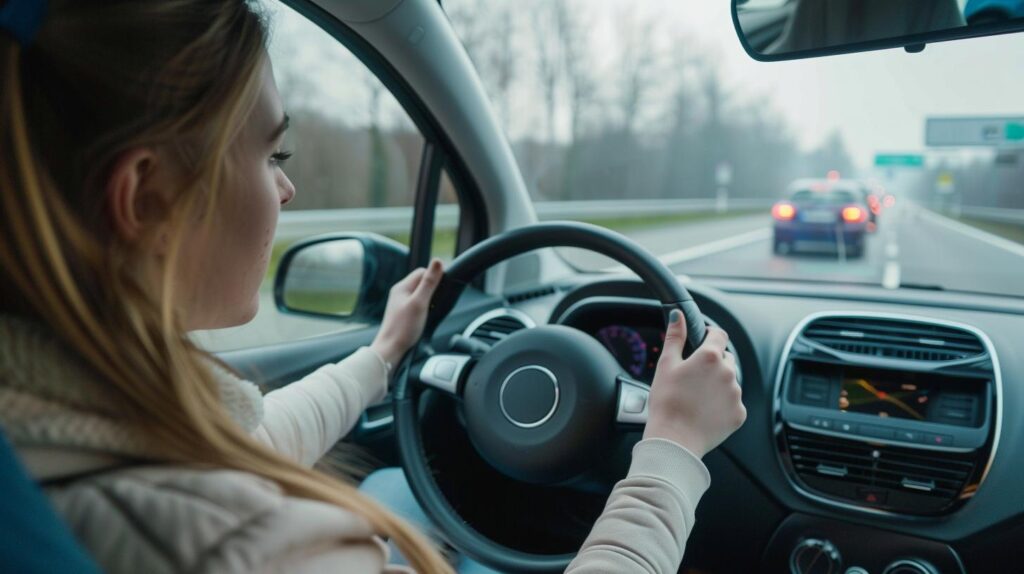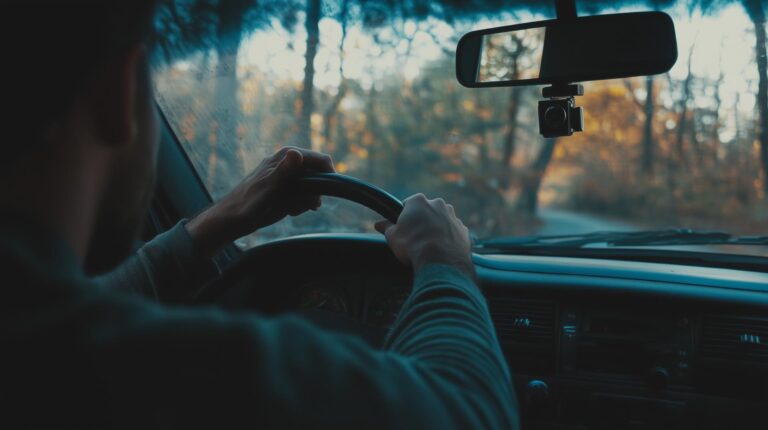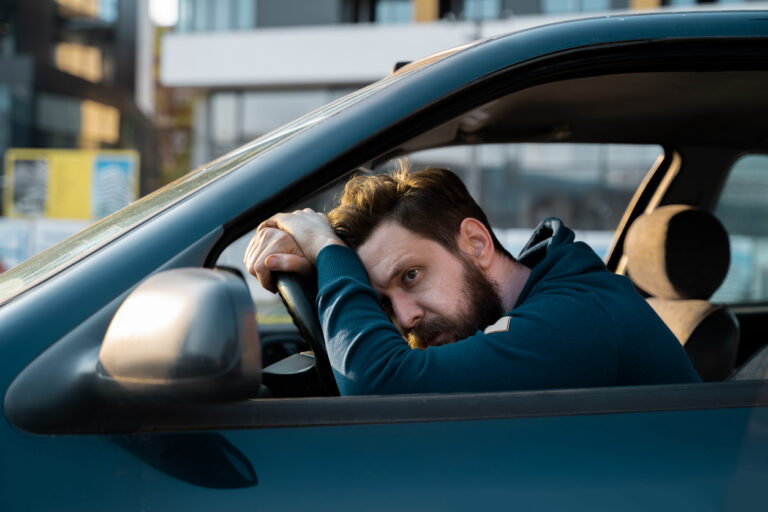Rear-end collisions are among the most frequent accidents in road traffic. This is often due to drivers keeping too little distance and tailgating the vehicle in front. The so-called braking distance formula is one of the things that learner drivers learn at driving school. But what does the braking distance depend on? And what exactly is the braking distance formula? We explain.
Know the braking distance and avoid accidents
In driving school, braking distance and its calculation is one of the least popular lessons. This is because the calculation task is not only part of the compulsory programme in the theory test, but is also relevant in the practical driving test - namely when it comes to the correct distance to the vehicle in front. Although minimum distances are prescribed by law, these are often not sufficient to ensure that your own vehicle comes to an accident-free stop when braking. If you do not know your braking distance, you will inevitably rear-end the vehicle in front and cause an accident.
Good to know:
- Inner city: At a speed of 50 km/h, a minimum distance of 15 metres should be maintained. This corresponds to approximately 1 second or 3 vehicle lengths
- Out of town: On rural and federal roads, the minimum distance is half the speedometer value in metres. At 100 km/h, this is 50 metres - at least for vehicles up to 3.5 tonnes. All heavier vehicles should maintain a distance of at least 50 metres from 50 km/h.
- On the motorway: Drivers should leave a particularly large distance here due to the often high speeds. But here too, half the speedometer is a good guideline
If you are unsure whether the distance is correct, you can use the black and white marker posts as a guide. These are set at 50 metre intervals outside built-up areas.
Even if you keep to the prescribed distances, it is often not possible to avoid an accident in the event of sudden braking. This is because these minimum distances are not intended to prevent rear-end collisions, but merely to minimise the damage. This is because the actual braking distance is significantly greater than the distances stipulated by the familiar rules of thumb. And it is significantly underestimated by most drivers. This is particularly noticeable on German motorways, where many fast drivers tailgate and often unknowingly risk serious accidents.
Have you been rear-ended by a car at too close a distance? The experts at fairforce.one will be happy to help you and will do everything they can to ensure that you get your rights.
Accident victims in your situation simply get the best support from fairforce.one.
Depending on the cause of the accident, customers receive an average of €4802 Additional payment
Callback within 5 minutes.
What is the minimum distance prescribed by the StVO?
The road traffic regulations state in § 4 The following:
(1) As a rule, the distance to a vehicle in front must be large enough so that it is possible to stop behind it even if it brakes suddenly. The vehicle in front must not brake sharply without a compelling reason.
Specific distances are therefore not specified. However, the familiar rules of thumb have become established as the standard in practice.
Braking distance, stopping distance, reaction distance - what is what?
Although many drivers are primarily familiar with the braking distance and at least roughly remember how it is calculated, there are other "distances" that are relevant for safe driving. This is because the braking distance is the time it takes for the car to stop after the brakes have been applied, but not the actual stopping distance. Your own ability to react is also relevant for this. This is why drivers should know the formulae for the reaction distance and the stopping distance in addition to the braking distance. But what is actually what?
Reaction path
The reaction distance is the first factor that is important for the braking process. This refers to the time a driver needs to recognise that they need to brake and actually initiate this process: In other words, pressing the brake pedal.
As a guideline, a Response time of 0.1 seconds for recognising the need to brake. For the actual braking or the Pressing the brake pedal takes 0.8 seconds. This means that the average driver needs around 1 second to react to a hazard or obstacle and apply the brakes.
That doesn't sound very much, but depending on the speed, it can mean a distance of several metres. There is a formula for calculating the reaction distance as a guide.
Reaction path Formula:
(speed in km/h : 10) x 3
This means that at a speed of 100 km/h, drivers already have to reckon with a reaction distance of 30 metres.
Reaction distance at 100 km/h:
(100 km/h : 10) x 3 = 30 metres.
These 30 metres therefore correspond to just under a second that drivers need to recognise a braking situation, react to it and press the brake pedal. However, the vehicle has not yet actually braked.
Braking distance
This is because the actual braking process is only initiated when the brake is applied and results in a braking distance that varies depending on the speed and weight of the vehicle. Specifically, the braking distance is the time from the moment the brake is applied until the vehicle actually comes to a standstill. All drivers will have seen the formula used to calculate the braking distance and will probably have done the maths themselves. This is because the task is part of the typical repertoire of the driving test.
Braking distance formula:
(speed in km/h : 10) x (speed km/h : 10)
This means that the braking distance at a speed of 100 km/h is around 100 metres.
Braking distance at 100 km/h:
(100 km/h) : 10) x (100 km/h : 10) = 10 x 10 = 100 metres
At a speed of 130 km/h, this is already 169 metres: (130 km/h : 10) x (130 km/h : 10) = 169 metres
A braking distance of 100 metres corresponds approximately to the distance between three black and white delineators. The next time you drive along a country road, why not check how long this distance really is?
Stopping distance
The reaction distance and the braking distance result in the so-called stopping distance. This is actually the relevant parameter, as it describes the distance that a driver or their vehicle needs to travel from first recognising a braking situation to actually coming to a standstill. Although the braking distance is often taught in driving schools, the stopping distance is the more important value. After all, if you only pay attention to the braking distance and ignore your own reaction time, you will usually still not be able to prevent a rear-end collision. To determine the stopping distance, simply add the reaction distance and the braking distance together.
Stopping distance Formula:
Reaction distance + braking distance = [(speed in km/h : 10) x 3] + [(speed in km/h :10) x (speed km/h : 10)]
What looks complicated at first glance is simply the sum of the previously determined values. It is therefore best to first calculate the reaction distance and the braking distance and then simply add the two results together.
In our example, at a speed of 100 km/h, a reaction distance of 30 metres and a braking distance of 100 metres results in a stopping distance of 130 metres.
Stopping distance at 100 km/h:
[(100 Km/h : 10) x 3] + [(100 Km/h :10) x (100 Km/h : 10)] = 30 metres + 100 metres = 130 metres
This means that a vehicle travelling at 100 km/h needs an average of 130 metres to come to a complete stop from the initial reaction to the actual braking process. To ensure this stopping distance, drivers on motorways, country roads etc. must maintain a distance equivalent to the distance between four black and white delineators. Be honest, do you keep to this distance?
Special case of emergency braking
The above formulae always assume a normal braking manoeuvre, not so-called emergency braking. This becomes necessary if a dangerous situation suddenly arises: for example, a child playing suddenly runs into the road between parked cars or a car overlooks a red light at a junction.
On motorways, the end of a traffic jam often necessitates emergency braking, as do obstacles on the road or other events that happen suddenly and require you to bring your vehicle to a halt as quickly as possible.
This reduces the braking distance in the event of emergency braking. This is because in such a situation, drivers usually depress the brake pedal fully with force and also operate the clutch at the same time. This shortens the braking distance in emergency braking situations. It is assumed that the normal braking distance is halved. There is also a calculation formula for this:
Emergency braking formula:
(Speed in km/h : 10) x (Speed in km/h : 10) : 2
At a speed of 100 km/h, the braking distance for emergency braking is therefore 50 metres:
(100 Km/h : 10) x (100 Km/h : 10) ÷ 2 = 50 metres
Accident victims like you get the best support from fairforce.one.
Have your accident reported now free of charge and without obligation by our regulation specialists.
What increases the braking distance?
The above formulae and values are always based on ideal conditions. They should therefore only be regarded as guidelines and may be longer depending on your personal situation, the vehicle being used and the road conditions. Many factors can influence the reaction distance and braking distance.
For example, the reaction path is influenced by
- Driver fatigue
- Poor lighting conditions or limited visibility
- Reduced responsiveness due to alcohol, medication or drugs
- Distractions (for example by passengers or children, loud music or similar)
The braking distance can be influenced:
- Wet or slippery road conditions (rain, snow, slippery surfaces, leaves, etc.)
- Poor road conditions
- Worn or dirty brake discs and/or pads
- Too little or too old brake fluid
- Worn tyres or tyres unsuitable for the weather conditions
- Incorrectly adjusted driver's seat or back seat (particularly important in the event of emergency braking)
- Overloading or incorrectly secured load
Steps towards the best possible claims settlement
Do you suspect that the other party in your rear-end collision did not keep the minimum distance? We will shed light on the matter and help you with the complete handling of the claim with our network of specialists.
This is the best way to proceed:
- You can report your accident to us by calling the toll-free number 0800 30 111 60 or simply online.
- An expert from our network will contact you within just 5 minutes to discuss the next steps.
- You take a deep breath and can now lean back, because the specialists from the fairforce.one network will take care of everything else and check your claims after a road accident.
FAQ on braking distance and stopping distance
How long is the braking distance at 100 km/h according to the rule of thumb?
At a speed of 100 km/h, the braking distance is 100 metres according to the rule of thumb. But beware, this is not the actual stopping distance, for which the reaction time must also be taken into account.
learn moreHow long is the braking distance at 50 km/h according to the rule of thumb?
If a car is travelling at 50 km/h, the driver should expect a braking distance of 25 metres under ideal conditions. However, drivers must take the reaction time into account for the actual stopping distance.
learn moreWhat is the braking distance at 100 km/h?
Anyone travelling at 100 km/h needs an average braking distance of 100 metres. If you factor in the average reaction time, the entire stopping process takes around 130 metres.
learn moreHow long is the braking distance at 50 km/h and 1 second reaction time?
The stopping distance, i.e. the distance that a car or its driver needs from the first reaction to a braking incident to the actual standstill of the car, is around 130 metres at 100 km/h and a reaction time of around 1 second.
learn moreWhat is the difference between braking distance and stopping distance?
While the braking distance only takes into account the actual braking process, the stopping distance also takes into account the reaction time that a driver needs to react to a braking-relevant situation. This means that the stopping distance is the actual distance that a driver needs to stop their vehicle.
learn moreHow long does it take a driver to react to an obstacle?
It is assumed that the average driver needs around one second to recognise the need to brake and initiate the braking process. But beware: due to tiredness, medication, poor visibility, distractions and similar factors, the reaction time can also be longer.
learn more




